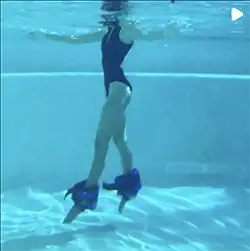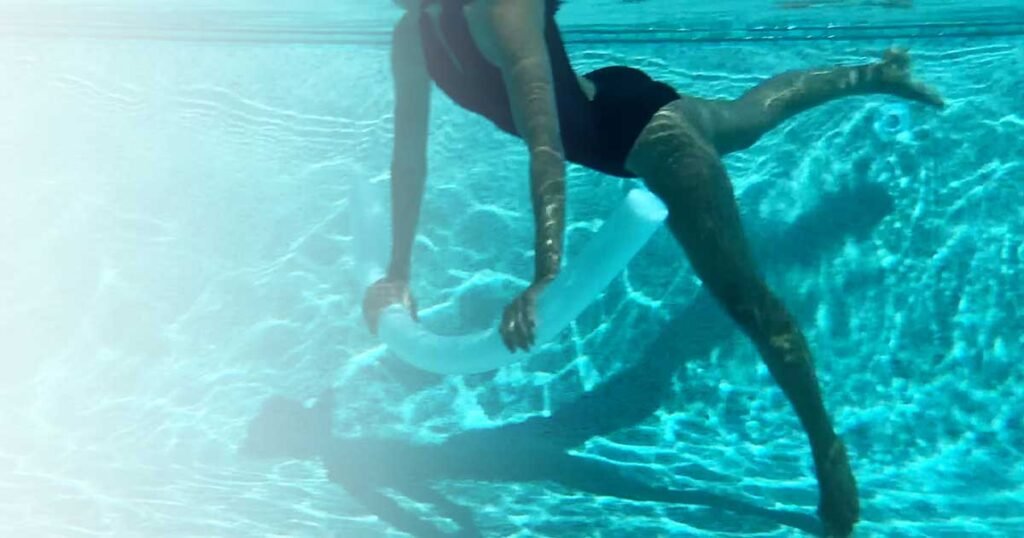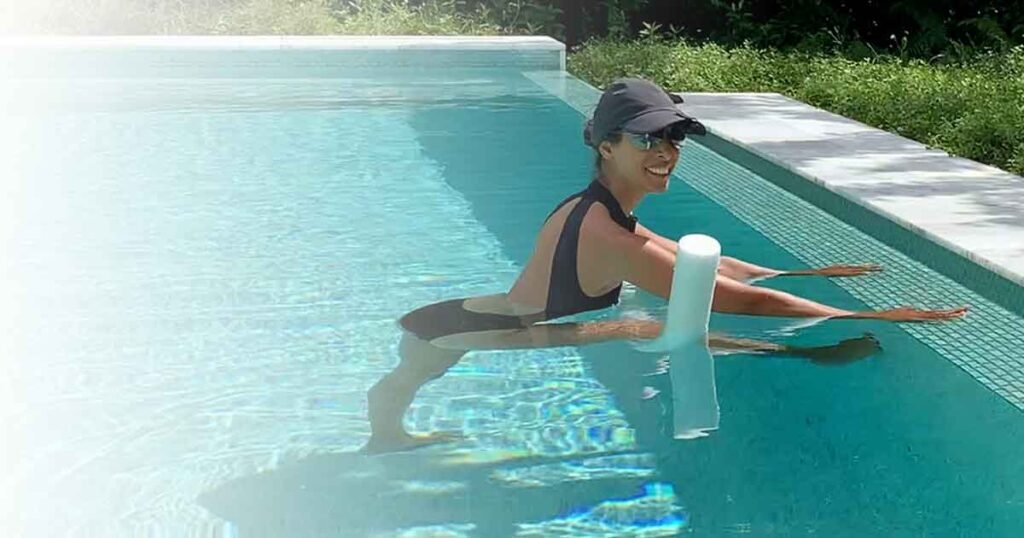Whether you are new to pool workout, you tried it in the past, or you practice it on a regular basis, there are a few important things you should know and keep in mind before jumping into the pool. The following guidelines will help you maximize the great benefits of exercising in the pool to safely and effectively achieve your fitness and health objectives.
1.Body and Water Temperature
Water temperature has a direct effect on the intensity of your exercise.
A normal body temperature is about 98.6° degrees Fahrenheit (37° degrees Celsius). As you exercise, your body generates additional body heat. The cool water draws heat from your body and lowers your temperature faster and more comfortably than when you try to cool down after land-based exercises. This means you can comfortably and safely perform a vigorous pool workout without getting sweaty and hot, or even overheating.
Just watch out for the opposite problem: getting too cold. Chilling can make you very uncomfortable, whether it happens because the water temperature is too low or whether you tend to have a low body temperature. If getting too chilly in the water is an issue for you, several aqua fitness products, such as neoprene vests and long-sleeved Lycra shirts, can help you conserve your core temperature and body heat.

The recommended pool temperature for typical water fitness programs is 83° to 86° degrees Fahrenheit (28° to 30° degrees Celsius). This range allows your body to enjoy the benefits of physical fitness without the discomfort of getting chilled.
High water temperature – even closer to 90° Fahrenheit (32° degrees Celsius) or above – is more suitable for therapeutic water-based activities, and mind-body programs like Aqua Pilates, Aqua Barre and Aqua Stretching, as well as Yoga, Tai Chi and others.
In water that is too cool – lower than 78° degrees Fahrenheit (26° degrees Celsius) – your body switches to survival mode. To keep your essential organs warm and functioning, the majority of your body fluids stay in your trunk. This leaves you with less blood circulating to your limbs, so your muscles remain cold and inflexible. This can result in muscle cramps (particularly in the lower leg), and it increases the risk of getting hurt. If the water is too cold, don’t take any risks – come back and enjoy your aqua fitness routine another day.
Remember that part of Mindful Movement is being aware of your body. Note how it is reacting. If you’re overheated or chilled, if something feels wrong or off, if you have a cramp or feel pain or discomfort, acknowledge it and address it. Keep yourself safe.
Mor’s Inside Tip: To adjust more comfortably to the change from air temperature to water temperature, begin your workout with a warm-up that includes large muscle movements. While you’re in the water, try to move constantly to keep generating heat. Your body will begin to cool down during even the shortest pauses – a great advantage on a hot day!

2. Pool Depth
Depending on the exercises and the equipment you use, you’ll carry out some of these aqua fitness programs in shallow water and some in deep water.
For shallow water exercises, submerge your body to chest level (mid-ribcage to armpit). The ideal pool depth for most shallow water exercises is 3.5 to 4.5 feet (1 to 1.4 m). At this depth, you’ll be comfortable doing shallow-water aerobics, water walking, or jogging, as well as carrying out aquatic strengthening, toning, and stretching movements. The aqua exercises presented later are all done in shallow water, that is, chest to armpit depth.
For deep water exercises, the ideal pool depth is 6-6.5 feet (1.8-2 m) or deeper. When executing a deep-water workout, your body is usually submerged to the neck and aligned in an upright position. You will know you have sufficient depth if you can point your feet and still not touch the bottom. You should have at least few inches between the tip of your pointed toes and the bottom of the pool. At this depth, you’ll be comfortable moving your body freely without hitting the bottom. I’ll expand more on deep water workouts later.

Mor’s Inside Tip: You don’t have to be an adept swimmer to enjoy shallow water exercises, but if you aren’t sure of your swimming ability, avoid deep water exercise. You can rehearse in shallow water, build your comfort level with the equipment, take advantage of floatation support (a floatation device, like a pool noodle – or even two noodles). Practice techniques like floating on your back when you feel unsteady or when you are making the transition from floating to standing up on your feet. If you feel safest in water where you can stand comfortably, shallow water work is best. If you feel unsure about getting into the water, join a class so you’re not alone, hire an instructor or work in a pool with a lifeguard.
The depth of the water affects the impact of your exercise, your body alignment and your motion control.
Be alert to these factors:
In shallow water programs, if the water is too shallow (waist level or below), you won’t be able to use your arms effectively, and you will exert more impact on your joints. If you try to perform shallow water exercises in water that is too deep (above armpit depth), the water will compromise your control over your movements and body alignment. You’ll be very unstable and may not be able to perform the intended movements correctly.
In deep water programs, exercising in water that is too shallow affects your body’s alignment and restricts your movements, since your feet might strike the pool bottom.
Most pools have a slope between the shallow and deep ends. When you’re doing shallow-water exercises with your feet touching the bottom, find a spot where you can place your feet evenly on a flat area of the bottom – not on an inclined area – so you can stand with stability and align your body correctly.
Mor’s Inside Tip: These water-depth pointers are important not just to give you the most benefit from your exercise, but to keep you feeling secure and safe in the water.
3. Water Properties
Body movement on land is affected primarily by gravity. That’s not true in the water, where your body reacts differently. That’s one reason you can’t do your gym workout in the pool. If you try your land-based exercise routine in the pool, you’ll realize quickly that natural forces simply don’t work the same in the water.
When you’re exercising in the water, gravity still has some effect, of course, but the water’s viscosity and buoyancy will shape your exercise program.
The water’s viscosity is the property responsible for providing resistance when you exercise. Water is about 800 times more viscous than air. The water’s additional resistance enables more intense movement and calls for greater muscle effort.
The viscosity of the water, your body size and frontal shape, and your speed create drag, the resistance you feel when you move in the water. The Aquatic Fitness Professional Manual explains that drag is a “combination of viscosity of the water and the relative speed of motion.” The water’s drag force is responsible for the consistent, balanced muscle load you can maintain as you execute an entire range of motions in the pool. Drag is the primary force you work against in the water.
Mor’s Inside Tip: When you are immersed, constant water resistance supports and surrounds you. You’ll feel it each time you move your arms, your legs or your whole body. That resistance gives aqua fitness its power to help you grow stronger. When you work out in the water, keep in mind that the water itself is providing your resistance (even before you add equipment). In this next section, I’ll discuss a few techniques you can use to modify the resistance you feel and to challenge your muscles a little more or a little less.
Buoyancy is one of the main reasons people work out in the water!
Being buoyant reduces the weight you bear in the water and lessens joint compression, both significant benefits of water workout.

When you exercise in water that comes to your chest or underarms, it is supporting 65 to 75% of your body’s weight. Water that comes to your waist supports about half your weight. And when you are in water up to your neck, the water is bearing 90% of your weight. Of course, these measurements vary with differences in people’s body weight and size, but generally the deeper you are immersed, the more of your weight the water is bearing.
Buoyancy will not dramatically affect the intensity of your exercise, but keep a few pointers in mind:
If you aren’t using floatation equipment, your body is pushing against the water’s resistance more than against its buoyancy. But when you use floating gear – pool noodles, hand buoys, and so on – you’re bringing more buoyancy to your routine and that – along with gravity – will affect how intense your exercise is.
The deeper you are in the water, the more you’re working against buoyancy. When you work at greater depth, you will find that you don’t have as much control over your movements as you do in shallow water. You’ll need to focus more on stability, kinesthetic awareness and proprioception – your sense of the relative position of the parts of your body in the water and the amount of strength you’re expending.
For shallow pool workout, I recommend standing at a depth between your chest and your armpits. At this depth, buoyancy doesn’t play a big role and won’t disrupt your movements. You’ll still have command over enough of your body weight to control your movements. If you go deeper than your armpits, you’ll notice that the water hinders your speed and your control.
As when you exercise on land, your body alignment and posture in the water are very critical to the effectiveness of your workout. Correct alignment and posture can help reduce your risk of injury.
Mor’s Inside Tip: In my workouts and when training others, I find that a person’s ability to make progress depends on correct body form and alignment. Everything else is contingent on that. The right form and posture can be a “green light” for progression and taking on more challenging variations of each exercise. If your posture isn’t correct, or if you find it too challenging to maintain the right posture throughout the exercise, I highly recommend going back to basic exercises and working with less intensity until achieving the right alignment and posture become easier for you.



